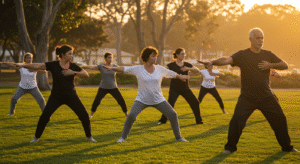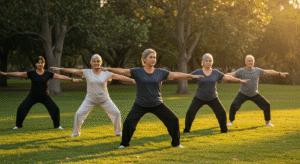Kneeling Benefits

What is the History of Kneeling?
When we think of kneeling, we might associate it with sports or religious practices, but kneeling, particularly half-kneeling, has a scientific foundation.
Half-kneeling is a fundamental human movement ingrained in our brain’s central nervous system. It’s a skill we develop around ten months of age, serving as a precursor to activities like squatting, standing, and walking.
We naturally learn how to control the half-kneeling position without formal instruction, marking an essential developmental milestone.
Benefits of Kneeling
There are numerous advantages to adopting a kneeling position, especially at a desk, as an alternative to sitting or standing.
Health Benefits
- It’s a biomechanically natural posture for the body.
- Engages the core muscles naturally, especially with a narrower stance.
- Places the spine and pelvis in a more neutral alignment compared to sitting or standing, reducing postural stress.
- Stimulates muscles that are often underutilized, improving overall endurance.
- Encourages more movement throughout the day.
- Allows for quick exercises like split-squats.
- Offers the same health benefits as standing versus sitting.
Other Benefits
- Requires no expensive equipment.
- Allows for maintaining eye level with sitting, eliminating the need for a new desk.
- Can be utilized in professional settings like boardrooms where standing might be inappropriate.
- Can be adapted to a chair by kneeling with one leg hanging off the side.
- Doesn’t require a height-adjustable desk to switch between sitting and kneeling.
Benefits of the Kneeling Posture
For many, kneeling may seem uncomfortable, but it carries more benefits than drawbacks and serves as a form of exercise, particularly beneficial for the body and lower back.
Benefits of kneeling:
- Improves blood circulation in the lumbar region, alleviating lower back pain.
- Promotes diaphragmatic breathing, enhancing lung function and digestive capabilities.
- Facilitates relaxation, reducing stress from daily life and work pressures.
Drawbacks of kneeling:
Prolonged kneeling can strain the knees, potentially leading to injury. Beginners are advised to start with 10-15 minutes per day and gradually increase to no more than 30 minutes.
Kneeling effectively strengthens the lower back, aiding in the treatment of back pain caused by spinal misalignment or poor blood circulation. A daily kneeling routine of 30 seconds in the morning can provide significant improvement.
During kneeling, pressure applied to the calf’s nose acupoint can alleviate knee pain, leg numbness, poor flexibility, athlete’s foot, and promote circulation, reduce swelling, and relieve stiffness.
Correct Kneeling Posture
When kneeling, avoid placing the body’s entire weight on the buttocks, which restricts mobility.
Instead, engage the inner thigh muscles slightly to support the body, leaving a small gap between the buttocks and the heels.
Maintain a straight spine while feeling slightly elevated, fostering a proper kneeling posture and reducing strain on the knee joints.















